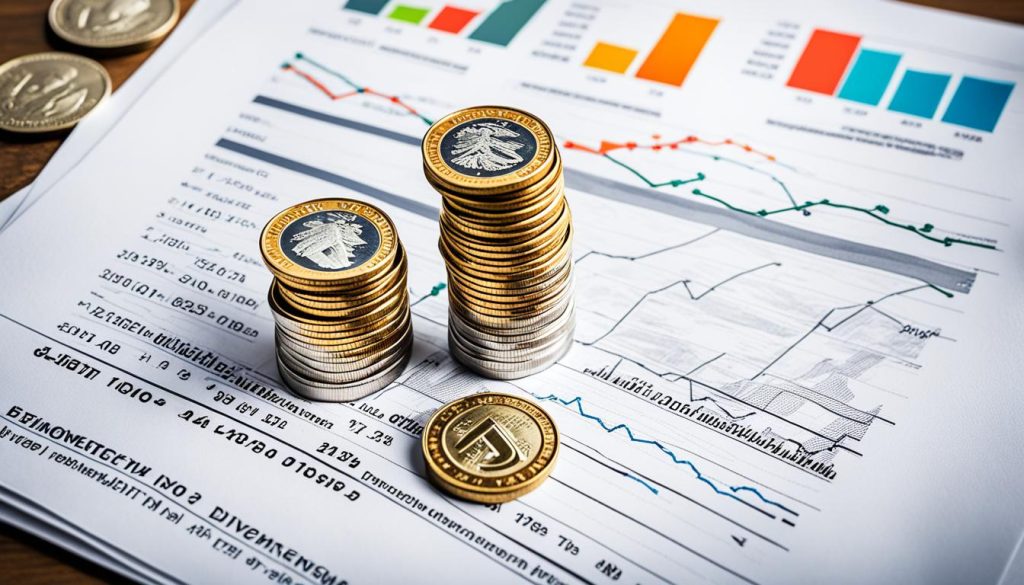Many investors chase the latest hot stock, hoping for a big win. But, fewer talk about building wealth through dividend investing. Dividend stocks may not be as flashy as tech stocks, but reinvesting their payouts is a reliable way to grow your portfolio1.
Investing in dividends might not be as thrilling as chasing the next big stock, but it offers a steady income. The average dividend yield on S&P 500 companies is between 2% and 5%1. This means you can earn a steady return even when stock prices go up and down. By reinvesting these dividends, you can slowly but surely build your wealth.
Key Takeaways
- Dividend investing provides a reliable source of portfolio income and can be a path to long-term wealth building.
- The average historic dividend yield on the S&P 500 range between 2-5%, offering a steady stream of returns.
- Dividend-paying stocks may lack the excitement of high-growth stocks, but their payouts can compound over time.
- Dividend investing strategies can be suitable for investors of all types, not just retirees.
- Dividend stocks have historically outperformed the broader market with less volatility.
What are Dividends and Dividend Investing?
Companies pay dividends to their shareholders from their profits. These payments offer a steady income to investors. Dividend investing means picking stocks that pay dividends often. The aim is to earn money from both the stock’s growth and the dividends.
Dividend Basics and Fundamentals
Dividends are usually paid every three months, but can be monthly or yearly2. Big names like Amazon and Alphabet don’t pay dividends, choosing to invest in growth instead2. Stocks that pay dividends can protect your investment during market lows, thanks to the dividend income2. These dividends are split into fractions for shareholders, showing how much of the company’s earnings are paid out2.
Dividend Yield and Its Calculation
The dividend yield shows the dividend return on your investment. You get this by dividing the yearly dividend by the stock’s price2. High yields can mean extra income, and companies that increase their dividends can offer growing returns3. But, be cautious of high-yield stocks with yields over 4.0% to 5.0%. These might signal financial problems or instability with the company3.
Assessing Dividend-Paying Stocks
When looking at dividend-paying stocks, it’s key to check a few important metrics. These metrics show if a company can keep and maybe increase its dividend payments. The dividend payout ratio, dividend coverage ratio, and dividend growth rate are vital to look at.
The Dividend Payout Ratio
The dividend payout ratio shows what part of a company’s earnings go to shareholders as dividends. If a company pays out less than 50% of its earnings, it’s seen as more stable. But, paying out more than 50% might make it hard to increase dividends or keep them up4. Investors like companies with a lower payout ratio. This means they might grow their dividends more in the future.
Dividend Coverage Ratio
The dividend coverage ratio tells us if a company can afford its dividend payments. It’s figured out by dividing earnings or free cash flow by dividend payments. A high ratio means a company can likely keep and maybe raise its dividends4. To really understand a stock’s dividend strength, look at the payout ratio, coverage ratio, free cash flow to equity, and net debt to EBITDA.
Dividend Growth Rate
The dividend growth rate is how fast a company’s dividend payments are going up each year. Companies that keep growing their dividends are usually more appealing to investors4. Investors often like companies that don’t pay out too much of their earnings in dividends. This hints at more dividend growth ahead.
| Metric | Evaluation |
|---|---|
| Dividend Payout Ratio | A lower payout ratio (under 50%) is generally preferred, indicating the potential for future dividend growth. |
| Dividend Coverage Ratio | A higher ratio indicates a stronger capacity to sustain and potentially increase dividends. |
| Dividend Growth Rate | Companies with a history of steady, sustainable dividend growth are often more attractive to dividend investors. |
“A combination of metrics including the dividend payout ratio, dividend coverage ratio, free cash flow to equity, and net debt to EBITDA are crucial for assessing the sustainability and quality of dividends in investing in dividend-paying stocks.”4
Risks and Downsides of Dividend Investing
Dividend investing can offer a steady income stream, but it comes with risks. Companies can cut or stop paying dividends without warning. This happened during the 2008-2009 crisis when many banks stopped paying dividends5.
High-growth companies, like those in tech, often don’t pay big dividends. They use their profits for research and growth5. Also, the yield on a stock can change a lot if the stock price changes, affecting dividends5.
High dividend yields can signal a company is in trouble, often because its stock price has fallen6. Certain sectors like real estate and utilities pay high dividends but can be hit hard by things like rising interest rates6.
Watch out for “dividend traps,” which have very high yields but are likely to cut dividends5. Companies in trouble might stop paying dividends to save cash, hurting their stock price6.
Dividend investing can be good, but it’s important to know the risks. Make sure your investments match your goals and are spread out well.
| Potential Risks of Dividend Investing |
|---|
| Dividend cuts or elimination |
| Lack of dividends from high-growth companies |
| Fluctuations in stock price affecting dividend yields |
| High dividend yields as an indicator of financial distress |
| Environmental factors, such as rising interest rates, making dividend stocks less attractive |
| Dividend traps with high risk of reduced dividend payments |
“Dividends are not guaranteed, and companies can cut or eliminate them at any time.”
dividends, dividend investing, income investing
Dividend-paying stocks are a top choice for those looking for regular income and growth. They often beat the market with less ups and downs7. Companies in sectors like basic materials, oil and gas, and healthcare are known for their steady dividends, offering yields above 2.5%7.
Dividend Stocks: Historical Performance and Volatility
Dividend stocks have shown strong performance over time8. They usually do better than stocks without dividends in total return8. Plus, reinvesting dividends can grow your investment over years8.
Dividend stocks are also less volatile than the market7. This is because they come from big, stable companies with steady cash flows. Their prices don’t change as much7.
Examples of Well-Known Dividend Stocks
Top dividend stocks include Chevron, Procter & Gamble, and Lowe’s. They’re part of the elite Dividend Aristocrats or Dividend Kings groups. These companies have raised their dividends for at least 25 or 50 years straight7.
| Company | Dividend Yield | Dividend Aristocrat/King |
|---|---|---|
| Chevron | 4.2% | Dividend Aristocrat |
| Procter & Gamble | 2.8% | Dividend Aristocrat |
| Lowe’s | 1.9% | Dividend Aristocrat |
These companies are known for their consistent dividend increases. They’re great for investors focused on income9.

“Investing in a broad basket of dividend stocks through an ETF can provide benefits of diversification and reduced risk.”
– Todd Rosenbluth9
Evaluating Dividend Stocks: Key Metrics
When looking at dividend stocks, there are key metrics to check out. The dividend yield is a key sign, found by dividing the annual dividend by the stock price10. For instance, a company with a $5 dividend and a $100 stock price has a 5% yield10. Big tech companies like Apple, Alphabet, and Meta Platforms could offer yields over 3% if they gave out all their Free Cash Flow (FCF) to shareholders11.
Dividend Yield and Other Ratios
The dividend payout ratio is another important metric, showing what part of a company’s earnings goes to dividends10. A ratio of 75% or less is good for strong companies, while 50% or less is better for companies with ups and downs11. The cash dividend payout ratio also matters, showing how much free cash flow goes to dividends. This gives clues on the dividend’s long-term stability.
Investors should look at a company’s total return, which is the sum of capital gains and dividend income11. Companies with a FCF yield higher than their dividend yield can easily support dividends without using cash reserves or debt11. Also, the earnings per share and price-to-earnings ratio help gauge a company’s financial health and growth chances.
By examining these metrics, investors can make smart choices about a company’s dividend future1110. To invest in dividends well, one needs to deeply understand a company’s finances and its ability to keep and grow its dividend over time.
Avoiding High Yield Traps
When you’re looking at dividend-paying stocks, don’t just focus on the high dividend yield. A high dividend yield might look good at first, but it could be a warning sign of a “dividend yield trap.”12 This happens when the stock price falls, making the yield seem better. But it could mean the company might cut its dividend in the future12.
It’s important to check the company’s finances, dividend payout ratios, and its history of dividend growth. A high dividend yield doesn’t always mean the dividend is safe or sustainable1213.
Be extra careful with high dividend yield stocks in real estate investment trusts (REITs) and master limited partnerships (MLPs). These sectors often have high payouts because of their business model12. Instead, look at cash flow, earnings trends, and if the company can keep or increase its dividend over time13.
By avoiding the dividend yield trap and looking at dividend stocks more deeply, you can find investments that are likely to last. This way, you can meet your long-term financial goals121314.

| Metric | Importance | Interpretation |
|---|---|---|
| Dividend Payout Ratio | Shows what part of profits a company pays out as dividends. | A high payout ratio (over 100%) might mean the dividend is not sustainable. A lower ratio means the company has more room to keep or increase its dividend. |
| Dividend Coverage Ratio | Checks if a company can afford its dividend payments. | A ratio under 1 means the company might struggle to keep its dividend. A ratio over 1 shows better coverage. |
| Dividend Growth Rate | Shows how a company’s dividends have grown and might grow in the future. | A higher growth rate suggests a strong company that values its shareholders. |
Looking at these key metrics helps investors understand if a dividend investment is likely to last. This way, you can dodge the dividend yield trap and make smarter choices121314.
“Successful dividend investing requires looking beyond just the yield and focusing on the overall health and prospects of the underlying company.”
Taxation of Dividends
Dividends are key in investment plans, but knowing the tax rules is vital. Most dividend stocks are “qualified,” taxed at 0% to 20% based on your tax bracket. This is lower than the 10% to 37% ordinary income tax rates15. Yet, some dividends, like those from REITs and MLPs, are “non-qualified” and face higher taxes16.
The tax on qualified dividends changes with your income and filing status. In 2023, those making over $44,625 or married couples over $89,250 face a 15% tax on these dividends15. For 2024, the tax rate is 0% to 20%, depending on your income and filing status1617.
| Taxable Income (2023) | Qualified Dividend Tax Rate |
|---|---|
| $0 – $44,625 (single) / $0 – $89,250 (married filing jointly) | 0% |
| $44,626 – $492,300 (single) / $89,251 – $553,850 (married filing jointly) | 15% |
| Over $492,300 (single) / Over $553,850 (married filing jointly) | 20% |
To get the lower tax rate, you must hold certain stocks for over 90 days before the dividend date15. Mutual funds also have to meet these holding periods to pass on the tax benefits15.
Remember, there are also state taxes and a 3.8% Net Investment Income Tax (NIIT) for some income levels15. Knowing about dividend taxes helps investors make better choices and increase their earnings.
Conclusion
Throughout this article, you’ve learned about dividends and dividend investing. These can be key to your income investing strategy. By grasping the basics of dividends, you can use them to grow your wealth over time18.
Dividend-paying stocks offer a steady income stream. They often do better than stocks without dividends, even when the market is shaky19. Plus, dividends can lower the risk and ups and downs of your investments. They help keep your money’s value steady19.
As you delve deeper into dividends, dividend investing, and income investing, pay attention to important details. Look at dividend yield, payout ratio, and growth rate. This way, you can find top-notch dividend-paying companies that meet your investment goals and comfort level1819.
FAQ
What are dividends and how do they work?
Dividends are payments from a company’s profits to its shareholders. They are usually paid out quarterly or yearly. These payments can make a portfolio more stable and provide income. They help protect against stock price drops.
How is dividend yield calculated?
To find the dividend yield, divide the yearly dividend per share by the stock’s current price. This shows the dividend return on your investment.
What metrics should I consider when evaluating dividend-paying stocks?
Look at the dividend payout ratio (dividends to earnings) and the dividend coverage ratio (company’s ability to pay dividends). Also, check the dividend growth rate over time.
Are dividends guaranteed and are there any risks to dividend investing?
Dividends aren’t guaranteed and can be affected by economic and company issues. In the 2008-2009 crisis, many big banks cut or stopped their dividends. High-growth companies often don’t pay big dividends, preferring to invest in research and development.
How have dividend stocks performed historically?
Historically, dividend stocks have done well, offering steady income and the chance for stock price growth. Companies like Chevron, Procter & Gamble, and Lowe’s are known for their consistent dividends. They are part of the top Dividend Aristocrats or Dividend Kings groups.
What are some key metrics to evaluate when analyzing dividend stocks?
Key metrics for dividend stocks include dividend yield, payout ratio, cash payout ratio, total return, earnings per share, and price-to-earnings ratio. These help gauge a company’s dividend sustainability and growth potential.
How can I avoid the “dividend yield trap”?
Be wary of stocks with unusually high dividend yields. High yields might mean a falling stock price, which could lead to dividend cuts. Always check a company’s financial health, payout ratios, and dividend growth history before investing.
How are dividends taxed?
Most dividend stocks pay “qualified” dividends, taxed at 0% to 20% based on your tax bracket. But, dividends from REITs and MLPs are taxed at higher rates as “non-qualified” dividends.
Source Links
- Is Dividend Investing a Good Strategy?
- What are dividends and how do they work?
- Dividend Investing: Pros, Cons and Rules to Follow
- 4 Ratios to Evaluate Dividend Stocks
- The Pros & Cons Of Dividend Stock Investing
- The Risks of Chasing High Dividend Stocks
- Dividends: Definition in Stocks and How Payments Work
- How to Develop a Dividend Investing Strategy | VanEck
- ‘Generate income without a paycheck’: How dividend investing can make you money while you sleep
- 6 key metrics every dividend investor must track | Sharesight Blog
- 5 Metrics That Are Far More Important Than a Stock’s Dividend Yield | The Motley Fool
- The 3 Biggest Misconceptions About Dividend Stocks
- Dividend.com
- Avoiding dividend yield traps: a comprehensive guide to protecting your investments | Australian Shareholders Association
- What Are Qualified Dividends, and How Are They Taxed?
- How Are Dividends Taxed? Dividend Tax Rates for 2023-2024 – NerdWallet
- Is There a Dividend Tax? Your Guide to Taxes on Dividends
- The Power of Dividends: Past, Present, and Future
- 5 Reasons Why Dividends Matter to Investors

